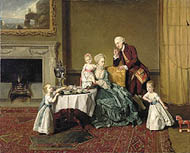Introduce your students to the many children represented in artworks at the J. Paul Getty Museum at the Getty Center. Eight activities allow students to make connections between their own lives and the lives of children from other places and time periods. Drawing, writing, and discussion activities encourage students to slow down, look closely, and think about what they see. |
 |
 |
1. Review the activities and decide if your students will do all or only selected activities.
2. Use the Itinerary & Map sheet to order the activities and create itineraries for your students.
3. The activities can be done in any order. Each chaperoned group will do the activities in a different order. All groups do Postcard Memories last.
4. Print out and make photocopies of the activity sheets for each student.
Below is a description of each activity:
Boy with a Dragon—Students are prompted to look closely at a sculpture of a boy with a dragon and then draw their own imaginary beast.
Detail Detective—Activity #1—Students look closely at a painting to make personal connections with their own lives and the child in the painting, and to identify shapes and patterns.
Detail Detective—Activity #2—Students hunt for details in a painting and make personal connections with their own lives and those of children in the painting.
Tea Time—Students interpret a painting by looking closely, and based on their observations, imagining what the characters would say.
A Girl and Her Dog—As a group, students discuss a portrait of an 18th-century girl.
Who Are We? (Part I and Part II)—Students examine and compare a sculpted and a painted portrait of two sisters. They then reflect upon their own family relationships.
Rescued!—Students learn about the story in a painting and then look closely at the details and textures in the composition.
Postcard Memories—Students write a postcard to a friend or family member, telling them about their trip to the Getty. |
 |
 |
 |
| John, Fourteenth Lord Willoughby de Broke, and his Family, Johann Zoffany |
 |
|
Visual Arts
Artistic Perception
1.0 Processing, Analyzing, and Responding to Sensory Information through the Language and Skills Unique to the Visual Arts
Students perceive and respond to works of art, objects in nature, events, and the environment. They also use the vocabulary of the visual arts to express their observations.
Aesthetic Valuing
4.0 Responding to, Analyzing, and Making Judgments about Works in the Visual Arts
Students analyze, assess, and derive meaning from works of art, including their own, according to the elements of art, the principles of design, and aesthetic qualities.
English-Language Arts
Writing
1.0 Writing Strategies
Kindergarten
Students write words and brief sentences that are legible.
Grades 1 & 2
Students write clear and coherent sentences and paragraphs that develop a central idea. Their writing shows they consider the audience and purpose.
Listening and Speaking
1.0 Listening and Speaking Strategies
Kindergarten
Students listen and respond to oral communication. They speak in clear and coherent sentences.
Grades 1 & 2
Students listen critically and respond appropriately to oral communication. They speak in a manner that guides the listener to understand important ideas by using proper phrasing, pitch, and modulation. |
 |

|

